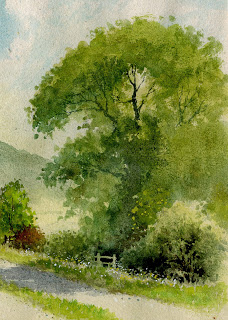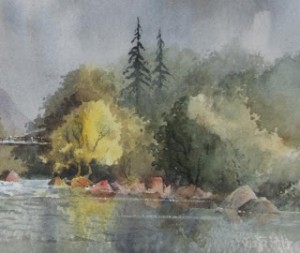There is something about the old stone bridges scattered about the mountain regions worldwide that feels such an idyllic subject for the landscape artist. The one I am featuring today stands on the River Artro in Snowdonia, a quiet, heavenly spot that has a calming influence on the mind. I have painted it a few times, and this view is looking upstream with light filtering through the trees.
The overwhelming greens in the top half of the composition have been tempered by the mixtures of French ultramarine and cadmium red in the lower segment, often with yellow ochre dropped in while the passage was wet. The contrasting effect of tall dark tree-trunks on the left, with the negative painting of the trunks of those saplings on the right helps to provide balance. The river naturally leads the eye up to the bridge, and I have kept the foreground water calm and lacking in detail in order to throw the emphasis on that which is closer to the bridge. The soft, blurred effect of the background trees also helps to accentuate the stronger lines of the bridge, and I have considerably reduced the number of trees in the scene.
I am delighted to say that the painting now hangs on display in Erwood Station art and craft gallery, which has just opened again, and very much in the manner of my dear friend Alan Cunningham who built it up into a highly popular venue, but who sadly passed away many years ago. It was quite an emotional moment to be invited back by Jenny, the new proprietor of the place that brings back so many happy memories. There are works by several artists and some of the most delightful crafts by talented local makers, as well as a terrific tea shop once again, and a beautiful river walk beside the Wye, so do drop in – it’s about 8 miles south of Builth Wells, just off the A470, telephone 07584 258947.
Finally, I’m so sorry I’ve been off the air for so long, but I went down with the ‘flu in December when I was about to send out a Christmas message, and so missed seeing the family over Christmas, including Catherine’s amazing performance as the Genie in Aladdin at East Grinstead. It took a while to get over it, and in mid-January I set off for northern Italy to explore the Alpine scenery around the Aosta Valley, though still not in perfect trim. However, it proved to be a spectacular trip and I will be covering it in my next blog. In the meantime I hope you are all making the most of this absolutely beautiful weather for sketching landscapes.




